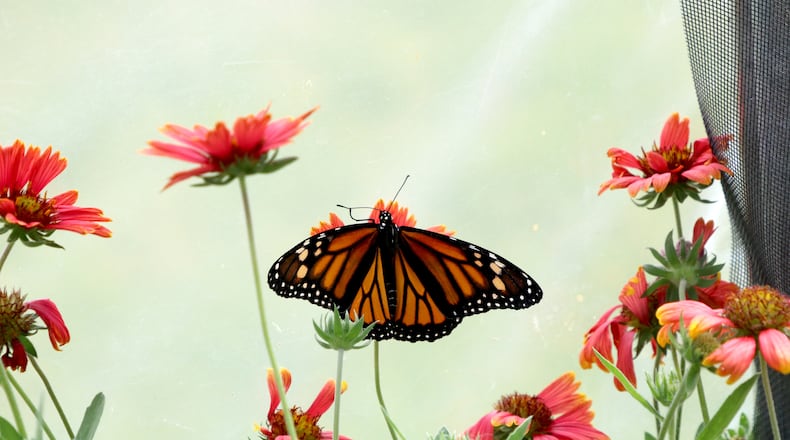“It did great — the monarchs came and I started watching. I saw one lay an egg on the underside of a milkweed leaf, and marked the leaf so I could watch it develop. One day, the egg hatched, but I couldn’t find the caterpillar,
and discovered that only one in 10 survive because of spiders, stink bugs, preying mantises and other predators.”
Hill found a source for supplies and information about raising monarchs and bought a cage. “I’d put a leaf with an egg in the cage, and became fascinated with the transitions as I watched the four stages of its life cycle.”
From egg to caterpillar to chrysalis and then butterfly. Hill said, “The caterpillar grows, finds a place to attach itself on a milkweed leaf, makes a web that becomes the chrysalis, which hangs there for about 10 days, then turns from lime green to black with orange dots, and a butterfly emerges.”
The first year, he raised 30 monarchs, 50 the next two, and this year about 48.
“Then, I got my brother started. The caterpillars will eat a whole leaf in a day, and I asked him and his wife, Judi, to ‘babysit’ while my family went on vacation.”
According to Ron Hill, his brother in Beavercreek, “when Dan brought over his ‘worms,’ Judi and I already had a cage and milkweed because we’d thought about raising them, but hadn’t gone as far as capturing caterpillars.
“After babysitting, though, we started looking for the caterpillars on our milkweed.”
“We use plastic water tubes that remind me of the ones we used to put our corsages in,” said Judi. “We put water in them, then add leaves and the caterpillars and put them into egg cartons to protect them until they emerge.
“We’ve gone one step further this year and are tagging the butterflies before release,” she added.
When the butterflies emerge, Don says “we let them sit for two-to-three hours until they flop a bit, then I grab them by the wings and we tag them.
“We got the tagging kit from monarchwatch.org. The tag is a very sticky, tiny dot, and we put it on a toothpick and transfer it to a certain spot on the wings.”
“It’s not time-consuming and we’ve raised, tagged and released 36 so far this year,” said Judi.
Their neighbor, Dr. Mary McCarthy, a trauma surgeon, has joined in. “I have a biology degree and am always interested in things like this, so thought I’d participate. Now, we have a shared garden bed,” she said.
“Every year, Bergamo Center (in Beavercreek) has a native plant sale, and I bought two types of milkweed last year and five more this year. Hopefully, our garden will expand and we’ll have more monarchs next year.”
McCarthy is fascinated with the tagging aspect. “Monarchs migrate to a specific place in Mexico, a very long migration. It’s surprising that people there search among the millions of monarchs, find the ones with the little white dots that contain numbers and a letter combo, and retrieve them.
“They can tell from those tags where they came from and track migration information. This is part of a Citizen Science Movement,” said McCarthy, who noted that even her grandchildren love the project. “They were here for a Labor Day picnic and played a hammock game of chrysalis to monarch — wrapping themselves in the hammock as a chrysalis, then breaking out as butterflies.”
Ages of the Hills and McCarthy range from 69-80, so raising monarchs has no age limit. And, as Judi likes to say, “We’re saving the world, one butterfly at a time.”
Contact this writer at virgburroughs@gmail.com.
About the Author



